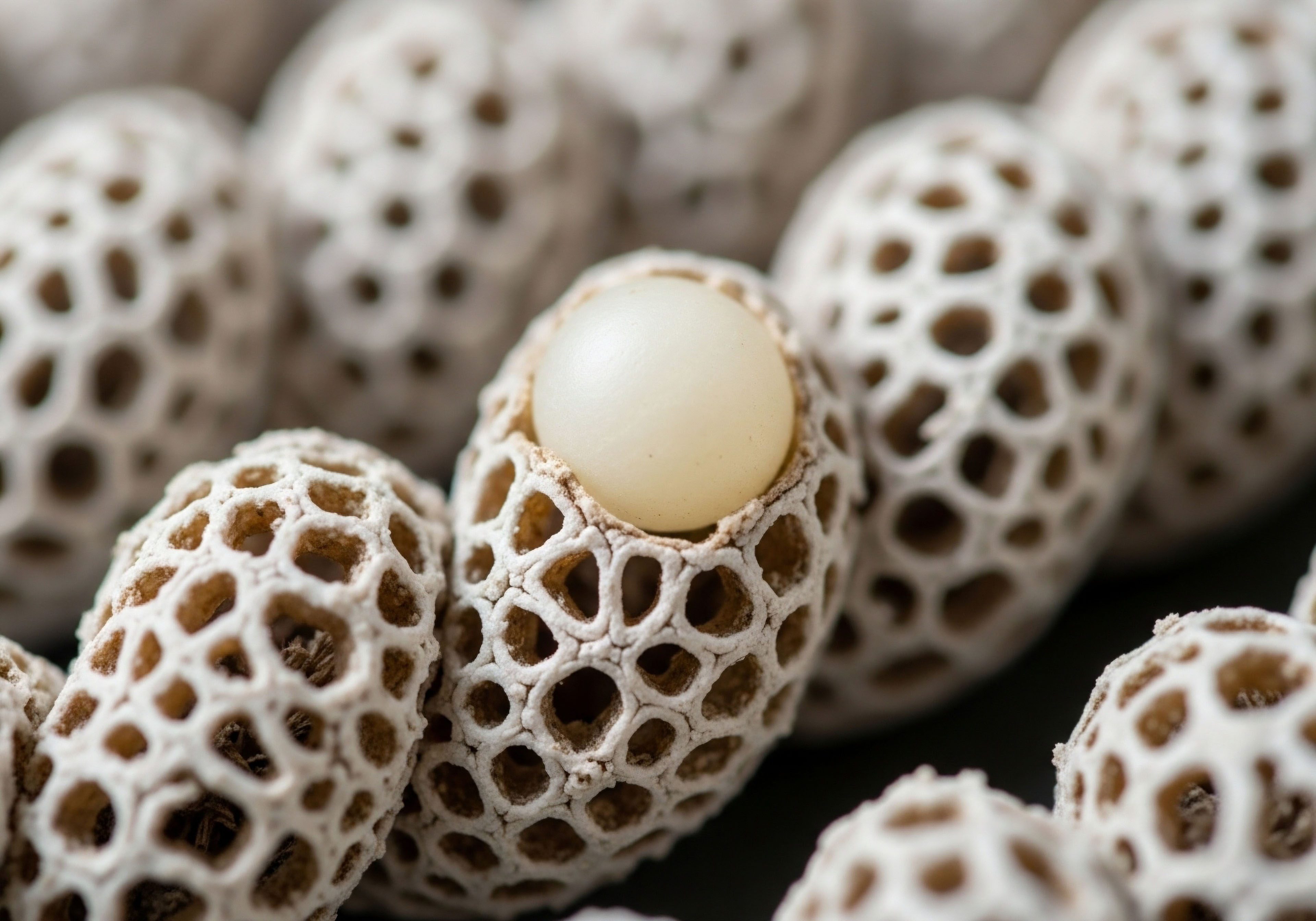

Fundamentals
The conversation around hormonal health for women has historically centered on estrogen and progesterone. This focus, while important, often overlooks a key player in female physiology ∞ testosterone. The feeling of vitality, sharp thinking, consistent energy, and a healthy libido are intricately connected to this androgen.
Your experience of shifting moods, a decline in physical strength, or a sense of persistent fatigue as you approach or move through menopause is a valid biological reality. These changes often correspond to the natural decline of testosterone, a process that begins years before the final menstrual period. Understanding this connection is the first step toward reclaiming your sense of self.
Women produce testosterone in the ovaries and adrenal glands, and before menopause, your body actually produces more testosterone than estrogen. This hormone is fundamental to maintaining bone density, muscle mass, cognitive function, and mood stability. As ovarian function wanes during the perimenopausal transition, the production of all three major hormones ∞ estrogen, progesterone, and testosterone ∞ begins to fluctuate and decline.
This hormonal shift is not a simple on-off switch. It is a gradual recalibration of your entire endocrine system. The symptoms you experience are direct reflections of this internal change. By the time a woman reaches post-menopause, her testosterone production can be less than half of what it was in her twenties.
Recognizing the profound impact of declining testosterone on a woman’s quality of life is central to developing a comprehensive wellness strategy during the menopausal transition.
The journey through perimenopause and into post-menopause is unique to each individual. Perimenopause is characterized by hormonal chaos. Estrogen levels may spike and crash unpredictably, leading to irregular cycles, hot flashes, and mood swings. Testosterone levels also begin their steady decline during this phase.
Post-menopause, by definition, begins one year after your final menstrual period. At this stage, estrogen and progesterone levels are consistently low, and testosterone levels have also reached a new, lower baseline. This distinction is critical because it shapes the therapeutic approach. In perimenopause, the goal is to stabilize a fluctuating system. In post-menopause, the objective is to replenish a deficient one. The approach to testosterone optimization must respect this evolving biological landscape.

The Shifting Hormonal Landscape
To appreciate the differences in testosterone therapy, one must first understand the distinct hormonal environments of perimenopause and post-menopause. These two phases represent a continuum of ovarian aging, yet they present unique clinical pictures that demand tailored interventions.

Perimenopause a Time of Fluctuation
Perimenopause can begin in a woman’s late 30s or 40s and is defined by its variability. During this time, the ovaries’ response to pituitary signals becomes erratic. This leads to unpredictable fluctuations in estrogen and progesterone. Testosterone production also begins to decrease, but its decline is often more linear and gradual compared to the wild swings of estrogen.
The primary therapeutic challenge in perimenopause is to address the symptoms of both estrogen deficiency and excess, while also accounting for the emerging androgen insufficiency. The presence of endogenous estrogen production, even if unreliable, influences how testosterone therapy is initiated and monitored.

Post-Menopause a State of Deficiency
Post-menopause represents a state of established hormonal deficiency. The ovaries have ceased their production of estrogen and progesterone, and testosterone output is significantly reduced. The adrenal glands continue to produce androgens, but at a much lower level. This creates a more stable, albeit deficient, hormonal state.
Therapeutic interventions in post-menopause are generally more straightforward, as the goal is to restore hormones to a physiological level that supports health and well-being. The absence of endogenous estrogen production means that testosterone therapy is almost always administered alongside estrogen and progesterone replacement to ensure a balanced hormonal profile.


Intermediate
When considering testosterone optimization, the clinical protocols for peri-menopausal and post-menopausal women are differentiated by their starting points and overall goals. The core principle is to restore physiological balance, but the context of the existing hormonal milieu dictates the specifics of the treatment plan.
A foundational element for both groups is the use of hormone replacement therapy (HRT) as the initial step to manage menopausal symptoms. Testosterone is typically considered an adjunct therapy when symptoms of low libido, fatigue, and cognitive fog persist despite adequate estrogen and progesterone replacement.
For a peri-menopausal woman, the introduction of testosterone is often more nuanced. Since her ovaries are still producing hormones, albeit erratically, the initial dose of testosterone may be lower, and the monitoring more frequent. The goal is to supplement her natural production without causing supraphysiological levels.
In contrast, a post-menopausal woman has a more predictable baseline of hormone deficiency. Her treatment protocol is designed to replace what her body no longer makes. The starting dose of testosterone might be more standardized, and the primary focus is on achieving and maintaining a steady state of hormonal equilibrium.
The primary distinction in testosterone protocols lies in accommodating the fluctuating hormonal environment of perimenopause versus the stable deficiency of post-menopause.

Protocols for Testosterone Optimization
The administration of testosterone in women is most commonly achieved through transdermal creams or gels, which allow for stable absorption and minimize the risk of adverse effects associated with oral or injectable forms. The aim is to achieve total testosterone levels within the normal physiological range for a pre-menopausal woman.

Peri-Menopausal Protocol Considerations
A woman in perimenopause requires a highly individualized approach. Before initiating testosterone, a comprehensive hormonal panel is essential to establish her baseline levels of estrogen, progesterone, and testosterone. The protocol often involves:
- Initial HRT ∞ Stabilizing estrogen and progesterone levels is the first priority. This may involve cyclic or continuous progesterone, depending on her menstrual pattern.
- Low Starting Dose of Testosterone ∞ A conservative starting dose of testosterone cream or gel (e.g. 1-3 mg per day) is typical. The dose is carefully titrated based on symptom response and follow-up lab testing.
- Frequent Monitoring ∞ Blood levels of total and free testosterone are checked at baseline and again at 6-8 weeks after initiating therapy. Adjustments are made in small increments to avoid androgenic side effects.

Post-Menopausal Protocol Considerations
For a post-menopausal woman, the protocol is generally more direct. She is typically already on a stable dose of estrogen and progesterone. The addition of testosterone is intended to address the specific symptoms of androgen insufficiency.
- Standardized Starting Dose ∞ A common starting dose for post-menopausal women is around 5 mg of testosterone per day, delivered via a transdermal cream or gel.
- Concurrent HRT ∞ It is crucial that post-menopausal women receive concurrent estrogen therapy to protect against endometrial hyperplasia and to achieve the full benefits of hormonal optimization. Transdermal estrogen is often preferred as it does not increase sex hormone-binding globulin (SHBG) to the same extent as oral estrogen, thus leaving more free testosterone available.
- Routine Monitoring ∞ After the initial titration period, testosterone levels are typically monitored every 6-12 months to ensure they remain within the target physiological range.

Comparing Testosterone Preparations
Several forms of testosterone are available for female use, though many are prescribed “off-label” as they are officially approved for men. The choice of preparation depends on availability, patient preference, and clinician experience.
| Preparation | Typical Starting Dose for Women | Application Notes |
|---|---|---|
| AndroFeme® 1% Cream | 0.5 mL (5 mg) daily | Specifically designed and licensed for female use in some countries; applied to the upper thigh or abdomen. |
| Testogel® 1% Gel | 1/10 of a sachet (5 mg) daily | Requires careful measurement of a small portion of a sachet designed for male dosing. |
| Tostran® 2% Gel | 1 metered pump (10 mg) on alternate days | A higher concentration gel that requires alternate-day dosing to achieve a physiological female dose. |
| Compounded Creams/Gels | Varies (typically 1-10 mg/mL) | Allows for precise, individualized dosing as prescribed by a knowledgeable clinician. |

The Importance of Monitoring
Regardless of menopausal status, monitoring is a critical component of safe and effective testosterone therapy. The goal is to alleviate symptoms while keeping testosterone levels within the healthy range for a young adult female. This minimizes the risk of side effects such as acne, hirsutism (unwanted hair growth), or voice changes.
| Monitoring Timeline | Assessment | Purpose |
|---|---|---|
| Baseline | Total and Free Testosterone, SHBG, Estradiol, Progesterone | To establish initial hormonal status and rule out contraindications. |
| 3-6 weeks post-initiation | Total Testosterone, Symptom Review | To assess initial response and check for signs of excess. |
| 3-6 months | Total Testosterone, Symptom Review | To confirm stable dosing and continued efficacy. |
| Annually | Full Hormone Panel, Symptom Review | To ensure long-term safety and maintenance of physiological levels. |


Academic
A sophisticated understanding of testosterone optimization in women requires moving beyond circulating hormone levels to the level of the cell. The concept of intracrinology is central to this discussion. Intracrinology describes the process by which cells in peripheral tissues synthesize active steroid hormones from inactive circulating precursors.
In women, particularly after menopause, the adrenal precursor dehydroepiandrosterone (DHEA) becomes a significant source of androgens and estrogens in tissues like the brain, bone, and muscle. This localized hormone production explains why serum testosterone levels do not always correlate perfectly with symptoms of androgen deficiency or excess. The cellular machinery responsible for these conversions can be influenced by a variety of factors, including age, genetics, and the presence of other hormones.
The primary difference in the endocrine milieu between peri-menopause and post-menopause lies in the contribution of the ovaries to the circulating pool of androgens. In a peri-menopausal woman, the ovaries still produce a significant, though fluctuating, amount of testosterone.
In a post-menopausal woman, ovarian androgen production is minimal, and the body relies almost entirely on adrenal precursors and peripheral conversion. This has profound implications for therapy. In the peri-menopausal state, exogenous testosterone is a supplement to an existing system. In the post-menopausal state, it is a replacement for a defunct one.

What Is the Role of SHBG in Testosterone Bioavailability?
Sex hormone-binding globulin (SHBG) is a protein produced by the liver that binds to sex hormones, including testosterone, and transports them in the bloodstream. When testosterone is bound to SHBG, it is biologically inactive. Only free or albumin-bound testosterone can enter cells and exert its effects.
Oral estrogen therapy is known to significantly increase SHBG levels, which can reduce the amount of free testosterone available to the tissues. This is a critical consideration when designing a hormone optimization protocol.
For a woman on oral HRT who is experiencing symptoms of low testosterone, switching to a transdermal estrogen preparation can lower SHBG and increase free testosterone, sometimes alleviating her symptoms without the need for exogenous testosterone. This highlights the interconnectedness of the endocrine system and the importance of a holistic approach to hormone replacement.

Challenges in Testosterone Measurement
Accurately measuring testosterone in women presents a significant analytical challenge. The low concentrations of testosterone in female serum are often below the level of accurate detection for the direct immunoassays used in most clinical laboratories. These assays were designed to measure the much higher levels of testosterone found in men and can be unreliable at the lower end of the female range.
For this reason, the gold standard for measuring testosterone in women is liquid chromatography-tandem mass spectrometry (LC-MS/MS). This method is more sensitive and specific, providing a more accurate assessment of a woman’s true androgen status. When LC-MS/MS is unavailable, clinicians must rely more heavily on clinical signs and symptoms to guide therapy, using immunoassay results as a general guide rather than an absolute measure.

How Does Menopausal Status Affect Androgen Metabolism?
The metabolic fate of testosterone and its precursors is altered by the menopausal transition. The activity of enzymes such as aromatase (which converts testosterone to estradiol) and 5-alpha reductase (which converts testosterone to the more potent androgen dihydrotestosterone) varies in different tissues and at different life stages. Understanding these nuances is key to predicting the effects of testosterone therapy.
- Aromatase Activity ∞ In post-menopausal women, adipose tissue becomes a primary site of estrogen production through the aromatization of androgens. This peripheral conversion is an important source of estrogen and can be influenced by the amount of exogenous testosterone administered.
- 5-Alpha Reductase Activity ∞ The activity of this enzyme in the skin and hair follicles is responsible for some of the potential androgenic side effects of testosterone therapy. Individual differences in 5-alpha reductase activity may explain why some women are more prone to acne or hirsutism than others, even at similar serum testosterone levels.
- Intracrine Dynamics ∞ The reliance on intracrine hormone synthesis from DHEA increases after menopause. This means that supporting adrenal health and providing adequate precursor hormones can be an important part of a comprehensive post-menopausal wellness strategy.
These complex interactions underscore the necessity of a personalized approach. The protocol for a peri-menopausal woman must account for the interplay between her endogenous hormone production and the exogenous hormones being administered. For the post-menopausal woman, the protocol is built upon a foundation of stable estrogen and progesterone replacement, with testosterone added to complete the physiological picture. The ultimate goal in both cases is the restoration of systemic hormonal balance and cellular health.

References
- Glaser, R. & Dimitrakakis, C. (2013). Testosterone therapy in women ∞ myths and misconceptions. Maturitas, 74(3), 230-234.
- Davis, S. R. Baber, R. Panay, N. Bitzer, J. Perez, S. C. & Lumsden, M. A. (2019). Global consensus position statement on the use of testosterone therapy for women. The Journal of Clinical Endocrinology & Metabolism, 104(10), 4660-4666.
- National Institute for Health and Care Excellence. (2015). Menopause ∞ diagnosis and management. NICE guideline.
- Wierman, M. E. Arlt, W. Basson, R. Davis, S. R. Miller, K. K. Murad, M. H. & Sluss, P. M. (2014). Androgen therapy in women ∞ a reappraisal ∞ an Endocrine Society clinical practice guideline. The Journal of Clinical Endocrinology & Metabolism, 99(10), 3489-3510.
- Islam, R. M. Bell, R. J. Green, S. Page, M. J. & Davis, S. R. (2019). Safety and efficacy of testosterone for women ∞ a systematic review and meta-analysis of randomised controlled trial data. The Lancet Diabetes & Endocrinology, 7(10), 754-766.

Reflection

What Does Vitality Mean to You?
You have now seen the biological blueprint of the female hormonal transition and the clinical strategies designed to support it. This knowledge provides a map, a way to understand the territory you are in. The data, the protocols, and the physiological explanations are tools.
They are powerful tools, but they are only part of the equation. The most important element is your own lived experience. How do you feel? What are your goals for your health, your energy, your clarity of mind? The numbers on a lab report are data points; your quality of life is the true measure of success.
This information is intended to be a starting point for a deeper conversation with a qualified clinician who understands the art and science of hormonal optimization. Your journey is unique. Your biology is specific to you. The path forward involves integrating this clinical knowledge with your personal health narrative to create a strategy that restores function and allows you to feel fully yourself. The potential to recalibrate your system and reclaim your vitality is within reach.



